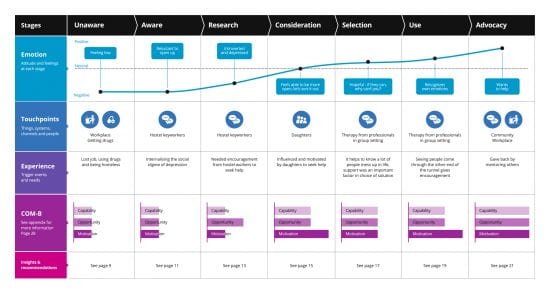CXJM is essential to help you lay down your plan of attack and start realizing the opportunities for delivering against customer experience objectives
It's no secret that most marketers are on the same trajectory and curve when it comes to Customer Experience. Although some are further along the journey than others, almost all are heading towards the common goal of achieving a single customer view. Therefore, most will have also had some exposure to Customer Experience Journey Mapping (CXJM) in some way, shape or form.
As an approach, CXJM is essential to help you lay down your plan of attack and start realizing the opportunities for delivering against customer experience objectives.
When conducted properly, the process will give you a better understanding of what the experiences of your customers really are and how you can start to plan effective communications around them.
Part of my role is now leading the entire Journey Mapping process and, having trialled a number of approaches, I believe a CXJM is only completed by following these 4 clear stages:
- Stage 1 - Empathy mapping – completed by core stakeholders, empathy mapping ends with a series of hypothesis on the audience’s experience to either prove or disprove
- Stage 2 - Audience interviews – used to provide a series of rich, qualitative based insights in response to the hypothesis defined from the empathy mapping
- Stage 3 - Mapping experiences – plotting the real customer behaviours across the stages of their experience (we have 10 stages that start with unaware and ends with advocacy)
- Stage 4 - Extracting the moments of truth – what are the audience’s defining moments from within their overall experience? When you can answer this, you can define a clear role for communications in responding to them with the right content, message or action
By following this approach to CXJM you can really start to understand your audience’s ‘moments of truth’ – the points along their journey that cause pain or delight.
During the audience interview, the experiences that are captured are ‘conscious’ – people are recalling and retelling them. But what about capturing those ‘unconscious’ experiences? The ones that only online behaviour, and data, leaves behind as a digital footprint?
Validate with data
This is where overlaying a combination of quantitative and qualitative data comes into play. By adding Validate with Data into the aforementioned process (yes, it’s now a 5 stage process) means you can enrich and measure the moments of truth with some robust figures alongside the insights from the qualitative interviews.
Let's be honest, one thing we all have far too much of is data (can I still hear an echo of “data is the new oil” from somewhen in 2012?). This stage of the process puts all that data to good use and can also help inform what data you need to harvest (and why) moving forward. The data you use to validate the experiences can vary on a case by case basis. However, from my experience, the following are all a good place to start:
- Search data – an absolute treasure trove of insights. Search data can provide you with what people are searching for, what questions they are asking, on what device and when they did it
- Social data – demographic as well as conversational data. Social listening, and looking at sentiment across forums and users comments, can provide even more context to the pain and gain points across the customer journey
- Web analytics – often one of the largest sources of data. How are your audience accessing your website? What are they engaging with and what their ‘conversions’?
- Heuristic assessments – an important qualitative analysis of both your owned properties and ideally those of your competitors
Why search data is so invaluable
Search data is only ever (really) analyzed by your SEO or Analytics team. However, when using search data as part of your CXJM process, search data really is ab-so-lutely invaluable. Quite simply, this is because people tell, or ask, Google the truth. People are happy to ask Google things they would not dream of asking anyone else. As their search intent becomes more clear through their logged queries, so too do the insights you can glean from them.
Seth Stephens-Davidowitz, author of Everybody Lies, argues that: “for a variety of psychological reasons, Google search is one of the best places to source unbiased audience information”.
Putting this into practice - using CX journey mapping to help Londoners of their wellbeing journey
A project from the NHS in London called “Good Thinking” is a great case study where we have put this process into practice.
The overall objective of the project is to improve the mental health of Londoners by encouraging them to self-manage their wellbeing. Our objective was to aggregate, structure and enrich existing research and understand how triggering contexts and experiences, associated with poor mental wellbeing, would translate digitally for the NHS.
With CXJM at its core, we followed our 5 stage process and used a combination of empathy and journey mapping, COM-B behavioural analysis, social listening and keyword research to uncover real conversations, trends, and patterns of behaviour.
The first step was to complete a series of empathy maps for the key intended audience groups. This activity involved stakeholders empathizing and mapping out needs, touchpoints, pain points and goals.
Next were the audience interviews, where the experiences of a group of Londoners was captured into ‘stories’. Their experiences were then mapped onto a CX journey map, which clearly indicated the blockers and challenges faced by them when trying to find the right information they needed online.
Now the moments of truth were known, we were able to use a combination of search and social data to add a sophisticated layer of information. We took the search data of millions of Londoners and were able to extract several learnings including:
- What search terms are the most popular and common in relation to mental wellbeing
- Which online touchpoints are people already using
- What sort of information and content they are being presented with

The social data provided richer context, giving a clear direction on the appropriate tone of voice, plus a validation on which platforms were the best to reach the various cohorts on.
This research was carried out last year and, fast-forwarding to today, we have already reached hundreds of thousands of Londoners and encouraged many of them to access the online resources that the service has to offer – thus alleviating pressure the stretched physical NHS and saving them hundreds of thousands of pounds in the process.
Marrying experience mapping with robust search and social data really does allow you to create a successful digital service – whether it’s designed to help the health of Londoners or something more commercially minded.
For a more detail on this approach download Fresh Egg's white paper, ‘Helping Londoners on the journey to mental wellbeing – a digital research project for the NHS’, to learn:
- How to identify and understand the online behaviour, motivations and search intent of people, in relation to broad wellbeing conditions
- Translating granular search data and broader trends into actionable insight
- Recommendations on how you can digitally engage with people at different stages of their wellbeing journey

Thanks to David Somerville for sharing his thoughts and opinions in this post. David is the Strategy Director at
Fresh Egg. David studied Bsc Hons Behavioural Science at University and has always had a passion for studying human behaviour, especially in relation to the external (non-cognitive) things that make us change how we behave and influence our decision-making process. This interest led him to a career in marketing and for the past 20 years he has been experimenting with ways of trying to change human behaviour, largely through content, messaging and language.. Recently Fresh Egg has been working with the NHS in London on a hugely worthwhile project aiming to improve mental wellbeing. You can follow him on
Twitter or connect on
LinkedIn.







 Thanks to David Somerville for sharing his thoughts and opinions in this post. David is the Strategy Director at
Thanks to David Somerville for sharing his thoughts and opinions in this post. David is the Strategy Director at 








